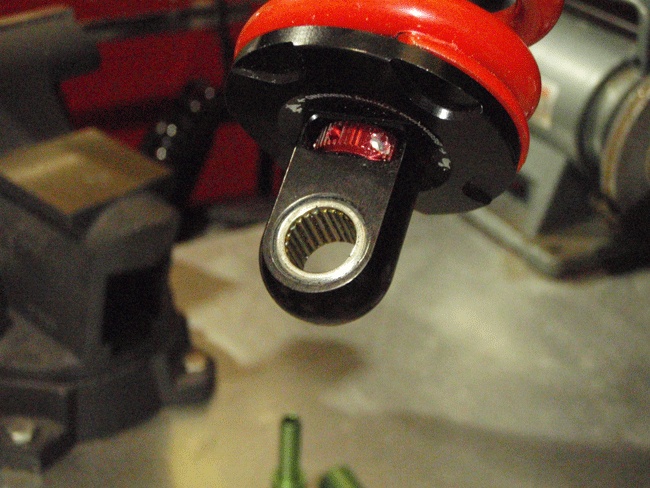
marcush. wrote:747 ..great CAD drawings..I´m bemused by the presence of Needle type bearings in a rocker arm svivel....that seems to me a good example for ignrant engineering (I hope this was not your work...)
My reasoning:
Needle bearings do not cope well to oscillating loads
Needle bearings are not coping well with dirt (think about track,carbon dust,mechanics having to service car in the field..) and shock loads....
The failure mode of a needle bearing will also lead to a quick dnf ....so never ever I would do this ,especially in this application where you could very easily substitute the needle cage by two angular contact ball bearings with out the risk of contamination.with a decent sealing (one call with Trelleborg or even just internet research will put you quickly in the right frame of thoughts)you will not have any risk of field service issues plus you have the variable of Thrust load/end float (slack!installation stiffness,apparent hysteresis-the system is behaving differently for different starting points of a input ) covered....oh I´m again a bit too cheeky here ..please forgive...I know I´m nitpicky .
I also noticed the use of needle bearings but I don’t see it as ignorant engineering. I even thought they would be better than ball bearings. Both ball bearings and needle bearings don’t like this static load with small oscillations because the entire load is resting on a single ball and doesn’t move very much. In this case a needle bearing should be better because the contact surface of a needle is bigger than that of a ball. Also because of the small diameter of the needles (I am talking about a radial bearing now, not the one visible on the picture) they can be placed closer together so the load can be spread over more needles. Therefore a needle bearing can take higher loads than a ball bearing. Furthermore it is smaller.747heavy wrote:no it wasn´tmarcush. wrote:747 ..great CAD drawings..I´m bemused by the presence of Needle type bearings in a rocker arm svivel....that seems to me a good example for ignrant engineering (I hope this was not your work...)

so feel free to pick on it, I guess there are many ways to skin a cat.
I have seen rockers with needle bearings and rockers without, both seem to work - both have won races.
I think the sealing is not really an issue, you can seal both types in a sufficient way. Normally in a Formula or Sports car, they are in a relative "clean" location, and only need to operate for a weekend, before they get serviced again.
Needle bearings seem to be quite common for ARB and pedals (brake/clutch) as well, at least I have seen them being used in such applications.
For the task at hand (1/4 model) I don´t think it´s a big issue either way, I guess I would settle for a single ball bearing, even this is probably too heavy.
The point I am very surprised about is that they use 2 axial bearings whereas I would use radial ones.
In a bell crank you usually have just radial loads, axial ones should be prevented because those can’t be transferred into the spring. How they carry the radial loads is not clear for me from this picture.
On a 1:4 car I would use a plain bearing.
They don’t care about high impulse loads or oscillating movements, they are cheap, small and reliable. Friction might be a bit higher but I don’t think it will give you any negative effect on a 1:4 car. Anyway I don’t really understand why there is such hype about reducing friction in a bellcrank bearing when you put a damper behind it anyways. The damper will cause higher friction than a plain bearing does.



